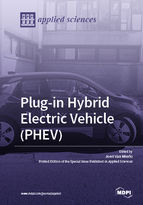Plug-in Hybrid Electric Vehicle (PHEV)
A special issue of Applied Sciences (ISSN 2076-3417). This special issue belongs to the section "Energy Science and Technology".
Deadline for manuscript submissions: closed (31 December 2018) | Viewed by 75865
Special Issue Editor
Interests: electric and hybrid vehicles (batteries, power converters, and energy management simulations); the environmental and economical comparison of vehicles with different drive trains and fuels (LCA and TCO)
Special Issues, Collections and Topics in MDPI journals
Special Issue Information
Dear Colleagues,
Climate change, urban air quality, and dependency on crude oil are important societal challenges. In the transportation sector, especially, clean and energy efficient technologies must be developed. Electric Vehicles (EVs) and Plug-in Hybrid Electric Electric Vehicles (PHEVs) have gained a growing interest in vehicle industry. Nowadays, the commercialization of EVs and PHEVs has been possible in different applications (i.e., light duty, medium duty, and heavy duty vehicles) thanks to the advances in energy-storage systems, power electronics converters (incl. DC/DC converters, DC/AC inverters and battery charging systems), electric machines, and energy efficient power flow control strategies.
This Special Issue is focused on the recent advances in electric vehicles and plug-in electric vehicles that address the new powertrain developments and go beyond the state-of-the-art (SOTA).
Topics of interest include novel propulsion systems, emerging power electronics and their control algorithms, emerging electric machines and control techniques, energy storage systems, including BMS, efficient energy management strategies for hybrid propulsion systems, vehicle-to-grid (V2G), vehicle-to-home (V2H), grid-to-vehicle (G2V) technologies and wireless power transfer systems (WPTs).
Prof. Dr. ir. Joeri Van Mierlo
Guest Editor
Manuscript Submission Information
Manuscripts should be submitted online at www.mdpi.com by registering and logging in to this website. Once you are registered, click here to go to the submission form. Manuscripts can be submitted until the deadline. All submissions that pass pre-check are peer-reviewed. Accepted papers will be published continuously in the journal (as soon as accepted) and will be listed together on the special issue website. Research articles, review articles as well as short communications are invited. For planned papers, a title and short abstract (about 100 words) can be sent to the Editorial Office for announcement on this website.
Submitted manuscripts should not have been published previously, nor be under consideration for publication elsewhere (except conference proceedings papers). All manuscripts are thoroughly refereed through a single-blind peer-review process. A guide for authors and other relevant information for submission of manuscripts is available on the Instructions for Authors page. Applied Sciences is an international peer-reviewed open access semimonthly journal published by MDPI.
Please visit the Instructions for Authors page before submitting a manuscript. The Article Processing Charge (APC) for publication in this open access journal is 2400 CHF (Swiss Francs). Submitted papers should be well formatted and use good English. Authors may use MDPI's English editing service prior to publication or during author revisions.
Keywords
- Plug-in Hybrid electric Vehicles
- Power Electronics converters for energy efficient drives for electric vehicles
- Energy management systems in plug-in hybrid vehicles
- V2G, G2V and V2H
- Charging infrastructure
- Energy storage






